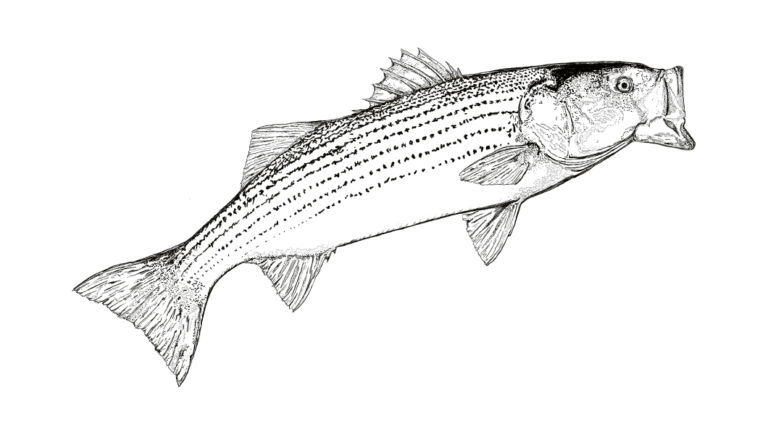Tar, Neuse, & Cape Fear Rivers


Why Can’t It Be Calculated?
FINDEX cannot be used to describe the status of Striped Bass populations in the Tar, Neuse, or Cape Fear rivers due to insufficient stock assessment data. No estimates of Spawning Stock Biomass are available, and no Target or Threshold values have been established for these populations. However, conclusions provided in the most recent fisheries management plan state that Striped Bass populations in the Tar, Neuse, and Cape Fear Rivers “are depressed to an extent that sustainability is unlikely at any level of fishing mortality.” A “Depleted” stock status designation in all three river systems is therefore strongly implied. The plan also concludes that hatchery fish are maintaining each population.
What is the impact of hatchery Striped Bass in these coastal rivers?
For all practical purposes, hatchery fish are solely responsible for the presence of Striped Bass populations in the Tar, Neuse, and Cape Fear rivers. Hatchery fish are stocked into the Tar, Neuse, and Cape Fear rivers each year at rates that approach 100,000 Striped Bass per river. While the stocking program was intended to “jump-start” population improvements by bolstering natural reproduction, this has not been the case. Hatchery fish grow fast in these systems, but they quickly disappear from each population (by age four or age five on average) before they can make significant spawning contributions. Habitat concerns (low river flows, blockages to spawning areas, inadequate transport to nursery areas) coupled with the low numbers of older, larger females in each system are often mentioned as reasons for poor reproductive performance.
Hatchery Striped Bass can be “recognized,” genetically speaking
Using advanced genetic tagging technologies, state agency biologists can calculate the annual contribution of hatchery fish in each river. Genetic material (a small piece of fin) is clipped from individual Striped Bass collected through a variety of sampling programs each year. The genetic material from individual fish caught in each river can then be compared with the archived genetic material from all the past parents (broodfish) used in hatchery production. The technique is similar to DNA fingerprinting, where each Striped Bass identified as a hatchery fish can be traced back to an individual mother and father previously used in hatchery production. Results of this yearly genetic “matching game” have a level of certainty exceeding 99.99%. The genetic marking program has been in place for Striped Bass in coastal North Carolina since 2010.
Hatchery Fish vs. Wild Fish
In the Tar, Neuse, and Cape Fear rivers, hatchery fish comprise 92% of the population. Simply put, fewer than 8% of Striped Bass were born in the wild within these three rivers last year, no matter their size or age. Now, let’s take a closer look at the genetic data for each river. Examining the data on Striped Bass origins in our rivers since 2013 offers valuable insights. Occasionally, specific years show a higher percentage of Striped Bass born in the wild, particularly notable in the Tar River in 2018. However, a clear and concerning pattern emerges when we analyze the long-term trends. It becomes evident that the Striped Bass populations in the Tar, Neuse, and Cape Fear rivers would be at risk of decline or disappearance over time without the vital support provided by hatcheries.
Tar River
No Data Found
Neuse River
No Data Found
Cape Fear River
No Data Found
Current Harvest Regulations
A moratorium has been in place for commercial and recreational Striped Bass harvest since 2019 in the Tar and Neuse rivers, and since 2008 in the Cape Fear River. Decades of stocking hatchery fish in these three systems has worked to maintain a population at low levels, but has nevertheless failed to provide for self-sustaining fisheries as evidenced by the near absence of naturally-born Striped Bass.
Potential Management Decisions
The following management decisions (and perhaps others) are being considered:
- Continue stocking hatchery fish with the goal of supplementing natural reproduction and providing for a self-sustaining population (the current goal). There is little evidence to suggest this alternative is likely to succeed without significant habitat improvements, changes in stocking practices, continued harvest restrictions or some combination.
- Continue stocking hatchery fish without worrying about their contribution toward natural reproduction. This alternative would allow for a relaxing of harvest restrictions as each population would be “artificial” and maintained by hatchery fish. Stocking rates and harvest could be increased or decreased based on management objectives.
- Discontinue stocking hatchery fish and allow the Striped Bass populations to find their own level of equilibrium. This alternative would result in low catch rates and the potential disappearance of Striped Bass from large portions of these rivers.
Did you know?
- Striped Bass stocked into the Tar, Neuse, and Cape Fear rivers are raised at the Watha State Fish Hatchery (Pender County) and the federal Edenton National Fish Hatchery (Chowan County).
- Broodfish in spawning condition are collected from each river every spring and transported to the hatchery. Typically, one female and three to four males are placed together in a circular spawning tank at the hatchery.
- Striped Bass broodfish (males too!) are injected with human chorionic gonadotrophin (HCG) which induces spawning within 30-36 hours.
- Striped Bass eggs hatch in 48 hours at a water temperature of 64℉.
- In June 2022, 189,000 hatchery Striped Bass were stocked into the upper Cape Fear River. The fish ranged in size from 1-2 inches. From 2010-2021, an average of 100,000 6–8 inch Striped Bass were stocked annually in various locations on the Cape Fear River.
- Hatchery Striped Bass (~100,000 per river) are stocked into the Tar and Neuse rivers each fall at a size of 6-8 inches.
What’s Next?
As our team diligently refines FINDEX, we are committed to delivering the most recent stock status updates for North Carolina’s diverse finfish species. Subscribe below to receive a stream of inshore insights and stay current with our coastal initiatives.
Stay Current
Sign up for our exclusive fisheries updates.

